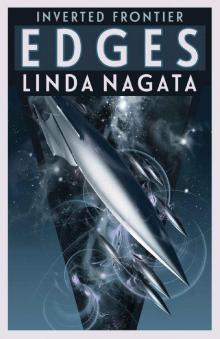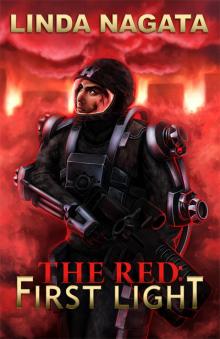- Home
- Linda Nagata
Edges
Edges Read online
Inverted Frontier
Edges
Linda Nagata
Published by Mythic Island Press LLC
Kula, Hawaii
This is a work of fiction. All the characters and events portrayed in this novel are fictitious or are used fictitiously.
Edges
Copyright © 2019 by Linda Nagata.
All rights reserved. No part of this publication may be reproduced, distributed, or transmitted in any form or by any means, including photocopying, recording, or other electronic or mechanical methods, without the prior written permission of the publisher, except in the case of brief quotations embodied in critical reviews and certain other noncommercial uses permitted by copyright law.
ISBN 978-1-937197-27-8
Cover Art Copyright © 2019 by Sarah Anne Langton
Mythic Island Press LLC
PO Box 1293
Kula, HI 96790-1293
MythicIslandPress.com
Prelude: Arrival
Against a starscape, a smudge of white light. A faint gleam, devoid of detail. Notable, because it had not been present when that sector of the Near Vicinity had last been surveyed by the array of telescopes in orbit around the Deception Well star system.
So it was something new, although not unknown.
A Dull Intelligence, assigned to analyze astronomical data, had observed such phenomena five times before during its twelve hundred years of existence. Knowing what that gleam portended, the DI tagged the object with a unique identifier: Transient Hazard 6 or TH-6.
The DI felt no excitement, no fear—it was capable of neither—only a simple, satisfying sense of duty as it confirmed its initial assessment by formally comparing the object’s spectral signature with database records. This exercise produced multiple matches of both luminosity and the spectrum of emitted light, providing unassailable confirmation of the object’s identity as a Chenzeme courser: an ancient robotic warship of alien origin.
“Chenzeme” was a human-coined term. No data existed on who or what the Chenzeme had been. They had originated—and likely vanished from existence—long before the human species evolved. But their robotic ships continued on, an autonomous fleet with genocide its singular purpose. For thirty million years, Chenzeme warships had patrolled this region of the galaxy, hunting for newly emerged technological lifeforms—and wiping them out.
The Dull Intelligence directed two telescopes to monitor the courser and determine its heading. It did not expect the courser to enter the Deception Well system.
The Well was a trap for such starships. It was a highly engineered star system consisting of only the central sun, a single planet, and an enveloping nebula. The nebula was artificial: a vast-and-slow thinking machine operating on a molecular scale. A weapon. One developed long before the beginning of human history, its purpose to infect the deadly Chenzeme starships, rewrite their motives, and quell the violent instinct that drove them.
The Chenzeme ships knew this—at least their behavior suggested they did. They were autonomous machines capable of learning and of communicating what they learned to one another—and not one of the five prior ships sighted by the DI had dared to enter the nebula despite obvious signs of technological life thriving on and around the solitary planet.
Still, the discretion shown by those past warships was not to be relied upon. This courser might choose to attack. If it did, the mechanism of the nebula would operate too slowly to ensure the safety of the Well’s human inhabitants.
The DI acted according to both instinct and its instruction set, sending out emergency notifications to the security council and to the Defense Force stations.
The people of the Well had not suffered a Chenzeme attack in the fifteen hundred years since they’d settled in the system—but they had not forgotten their history. They’d emigrated to the Well only after a massive Chenzeme assault left their beloved home world of Heyertori uninhabitable and their people on the edge of extinction. So alongside the ancient, protective mechanism of the nebula, they maintained twin warships—Long Watch and Silent Vigil—stationed opposite each other on the nebula’s periphery. Both ships were dark and stealthy and fearfully well-armed. If the courser made a sunward run, threatening the world of Deception Well, those ships would work together to blow it out of the sky.
Chapter
1
Riffan Naja rarely thought of himself as a military commander. Really, he was an anthropologist. The study of human society was his specialty, his passion. It was the reason he’d sought a position aboard Long Watch.
Any position aboard either Silent Vigil or Long Watch required extensive Defense Force training—after all, the primary duty of both ships was to guard the Deception Well system against Chenzeme incursion—so Riffan was qualified as a military commander. He had just never expected to use his military training.
No one had expected him to use it because seven centuries had elapsed since the last time a Chenzeme ship was sighted. It had been even longer—twelve hundred years—since a human starship visited the system. Career Defense Force officers had long ago deemed duty aboard either ship too dull to endure.
So over time, Silent Vigil and Long Watch became scientific platforms as well as watch posts. Career officers were no longer posted to the remote duty. Instead, the position of commander rotated among each ship’s senior scientific staff.
Riffan happened to be in command when the emergency notification arrived.
He was alone in the hexagonal chamber of his study, eyeing a complex display of charts and evolving schematics that described the observed orbital motion of debris around an abandoned planet in a distant star system. He hoped a thorough analysis of the data would reveal some anomaly that could be explained only through the presence of a technological lifeform—specifically, human survivors, finally recovering from an assault that had ravaged their system centuries ago.
The alert shattered his concentration with a triple warning-tone that bleated across his brain. His whole body recoiled, his bare foot kicking free of the loop that had anchored him in place in the zero-gravity environment of Long Watch.
He scrambled to catch a hand-hold as the display refreshed and the calm, familiar voice of the astronomical Dull Intelligence spoke into the artificial neural organ of his atrium: *Alert. Alert.
His atrium’s tendrils wound throughout his brain tissue, linking his senses to the ship’s omnipresent network, allowing him to hear the DI, even though the workroom remained silent.
As the Dull Intelligence continued to speak, a text version of its words appeared on the display:
*A newly sighted object, designated Transient Hazard 6, confirms as a Chenzeme courser. Approximate distance, nine light-hours beyond the periphery of the nebula.
Riffan finally caught a hand-hold. He squeezed it in a painful grip. “No,” he whispered as additional data posted to the display. “No, no, no. Love and Nature and the Cosmic First Light, this can’t be right. This can’t be happening. There has to be a mistake.”
*There is no mistake, the DI assured him in its calm way.
“Well then, damn it, why now?” he demanded. “Why me?”
The DI knew better than to attempt an answer and after a moment, Riffan settled the question for himself: “You fool, it had to be someone, didn’t it?”
Seven hundred years was a long span on a human scale. The absence of sightings for all that time had led some to speculate that the ancient robotic warships had already won this latest phase of their endless war of extinction, that Deception Well, nestled within the weaponized nebula, was the last surviving human settlement. With no viable targets left to hit, the warships had withdrawn—so the theory went—to wait with machine patience for the emergence of some future technological species whose history they wo
uld subsequently cut short.
Riffan was aboard Long Watch to prove this theory false. He refused to believe Deception Well was the last refuge of humankind. He’d aimed his studies at detecting signs of a surviving human presence, though he’d been unsuccessful, so far. A Chenzeme vessel appearing on his watch struck him as cruel irony. Its existence disproved the theory, without offering hope of other survivors.
“Focus, you idiot,” he ordered himself.
Academic arguments didn’t matter. Other worlds didn’t matter. Not now. All that mattered now was the defense of Deception Well.
He closed his eyes a moment. Drew a deep, calming breath. Then another. Sliding into the role he’d trained for: Defense Force commander. If this Chenzeme courser approached the system, it was Riffan’s duty to direct Long Watch against it.
He sent his first order out over the ship’s network, his voice mostly steady: “All senior crew report to the bridge now. Everyone else, summon your external equipment and see that it’s safely stowed. Secure your internal gear, and configure your quarters for acceleration.”
Then he punched out through the gel membrane that served as the door of his study, shooting into a round-walled passage. Two worried-looking students and a maintenance drone scrambled to get out of his way as he launched himself toward the bridge.
<><><>
Deception Well was the farthest outpost of the human frontier in the direction known as swan, named for the still-distant supergiant star, Alpha Cygni, brightest light in the constellation of the swan as seen from old Earth.
The first Chenzeme ships ever sighted had come out of the swan, probably originating from somewhere far beyond Alpha Cygni. This newest courser had come from that direction too.
The luminosity of a Chenzeme warship’s hull was a known factor that allowed the astronomical DI to work out the courser’s distance from Long Watch, while the Doppler shift provided a rough estimate of its relative velocity. The implication was ominous.
Riffan reached the bridge just behind the ship’s senior astronomer, Enzo Hui. “You’ve seen the numbers?” Enzo asked in a low voice.
“They don’t look good,” Riffan murmured.
He kicked off the wall, shot through a detailed holographic projection of the Near Vicinity that filled the central volume of the chamber, and then arrested his glide at a workstation on the opposite side of the room.
In its current configuration, the bridge held four workstations evenly spaced in a ring around the plane of the designated floor. Enzo took the station on his right. Exobiologist Pasha Andern already occupied the station to his left.
Without looking up, Pasha said, “I’m going over the historical record. Transient-Hazard 6 is closer to the periphery of the nebula than any previously recorded Chenzeme ship.”
“Understood,” Riffan said as he shoved his bare feet into stirrups that would hold him in place at his workstation. “Its velocity relative to the system also appears significantly slower than past sightings.”
The door drew open again. Past the holographic projection, Riffan saw the ship’s engineer, Zira Lin, glance around the chamber, her eyes wide, lips slightly parted.
Riffan sensed her fear and shared it. His heart raced. His hands trembled, though he strove not to show it. He had a role to play. The amateur acting he’d done helped him to keep his voice steady as he addressed his companions.
“This is serious, friends,” he told them, watching Zira take her place at the station opposite him. “In our sixteen-hundred-year history at Deception Well, no Chenzeme ship has ever tried to enter the nebula. I hope TH-6 will pass on too, but right now it is not behaving like any courser we’ve observed before.”
“Its behavior is frankly ominous,” Pasha interjected, a hard edge to her voice. The exobiologist had spoken without looking up, her right hand moving in steady rhythm as she scrolled a display on the slanted surface of her workstation. “Why would its velocity be so low, unless it intends to come in? We know that can happen. It’s happened at least once before.”
Riffan grunted agreement. The evidence of that long-ago incursion haunted Deception Well’s night sky. Caught in the planet’s gravity well was the dead dark hulk of a swan burster—a gigantic, ring-shaped Chenzeme warship far larger than a courser—easily visible despite its high orbit.
Like all swan bursters, this one had once carried a gamma-ray gun capable of boiling oceans and burning off planetary atmospheres. It was harmless now, but in some long-gone, pre-human era it had penetrated the nebula and reached Deception Well intact.
Riffan said, “If TH-6 tries to come in, we’ll work with Silent Vigil and do what’s necessary to stop it.”
“We’ve got time to work out what it’s doing,” Enzo said. “Maybe days. The courser is slow, but it’s not slow enough to survive the nebula. It’ll have to dump velocity if its target is Deception Well.”
That was true. If the courser entered the nebula at its current speed, its mass would be quickly eroded by continuous micro-collisions with the nebula’s tiny grains of debris, and eventually it would be destroyed. That was the good news. The bad news, Riffan thought with a sinking feeling, was that this awful encounter could stretch on for days.
“It might not slow down,” Zira said in a trembling voice. “Not if this is a kamikaze mission. Depending on its angle of entry, it might be able to survive long enough to deploy its gamma-ray gun against the space elevator, or worse, aim its mass at the planet. With enough momentum, a collision could shatter the crust and destroy the atmosphere. One courser is a small sacrifice if it means wiping out the last surviving settlement anywhere on the frontier.”
Love and Nature! Leave it to an engineer to find the worst-case scenario.
“We are not the last surviving settlement,” Riffan said. “There are others out there, somewhere, and someday we are going to find them. And there is no historical record of Chenzeme ships ever employing a suicide attack.”
“Because they’ve never had to?” Pasha wondered. “Our situation here is unique. Chenzeme tactics might prove unique too.”
“I agree,” Enzo said, eyes half-closed as he communed with the ship’s information system.
Riffan nodded. “We’ll keep that possibility in mind, but right now, Enzo, we need you to calculate the courser’s trajectory. That will tell us if we’ve got a fight coming.”
“I’m working on it,” the astronomer assured him. “But it’s going to take time.”
“Understood.”
To work out the courser’s trajectory, Enzo had to map its relative motion against background stars—and at its present distance many minutes would have to elapse to detect any motion at all.
Riffan looked across the holographic projection to the engineer. “Zira, I want you to reconfirm all systems. Ensure everything’s in peak condition. But keep us silent. Don’t give our position away.”
She sniffed a little, and nodded. “All systems are in peak condition, but I’ll run the checks again.”
“Thank you.” He turned to his left. “Pasha—”
“I’ve already run system checks on the gamma-ray gun,” she said crisply. “All nominal.”
In ordinary circumstances, Pasha spent her hours studying the tiny artificial lifeforms that inhabited the nebula, but for the extent of this emergency, she would serve as weapons officer. Cool and unruffled, she appeared particularly well-suited to the task—though she’d never had an opportunity to fire the weapon. Over the centuries, the laser had been test-fired only three times. The security council feared the weapon would be a beacon to draw the Chenzeme—but they would use it if they had to.
Riffan sighed, now that the first panicked flurry of activity was past. His gaze drifted over the holographic projection, really seeing it for the first time since he’d entered the bridge. It was a high-resolution, three-dimensional model of the Near Vicinity. At the center, a tiny bright sphere represented Kheth, Deception Well’s star. The vast scale of the projection gave an ill
usory impression that the solitary planet was nestled very close to its sun. The blue-green orb was shown as a dot, far smaller than Kheth, but still exaggerated in size to make it visible on this scale. A silver wisp represented the column of the space elevator that linked the planet’s surface to the orbital construction yards. The city of Silk, mounted on the elevator column, was indicated by a glint of golden light.
Extending far beyond the orbit of the planet was the artificial nebula, its outer boundary represented by a translucent, spherical green shell. A blue flag at the edge of the nebula marked the position of Long Watch. Another indicated Silent Vigil, on the opposite side of the sun.
Vastly farther out, the Chenzeme courser. A red flag marked its position, making it clear that Long Watch was situated to encounter it first—if it was bound in-system.
And if it was inbound? He worried it was not alone.
Warships like this one were known to run in pairs, with one ship dark. Cold and dark and therefore invisible, its propulsion reef quiet as it coasted through the void on a pre-planned trajectory designed to bring its gun into position to deliver maximum destruction. A trajectory detectable only if it chanced to eclipse some background object while the narrow eye of a telescope was turned its way.
He linked to the astronomical DI. *Re-examine all survey imagery. Look for any indication of a second ship, running dark.
*A re-examination is already underway.
Good.
He turned to the astronomer. “Enzo? We really need that trajectory. A rough estimate, at least.”
Enzo shook his head. “Not yet. Not for a while. But if we put another telescope on it—”
“No, I don’t want to do that,” Riffan said. “We know where the courser is. What we don’t know is whether or not it’s alone. Now more than ever, we need to continue the standard full-sky scan.”

 Nightside on Callisto and Other Stories
Nightside on Callisto and Other Stories Pacific Storm
Pacific Storm Edges
Edges The Red
The Red The Red: First Light
The Red: First Light The Martian Obelisk
The Martian Obelisk Limit of Vision
Limit of Vision Going Dark
Going Dark The Last Good Man
The Last Good Man The Trials (The Red Trilogy Book 2)
The Trials (The Red Trilogy Book 2) Deception Well (The Nanotech Succession Book 2)
Deception Well (The Nanotech Succession Book 2) The Year's Best Science Fiction & Fantasy 2013
The Year's Best Science Fiction & Fantasy 2013 The Dread Hammer
The Dread Hammer Skye Object 3270a
Skye Object 3270a The Bohr Maker
The Bohr Maker